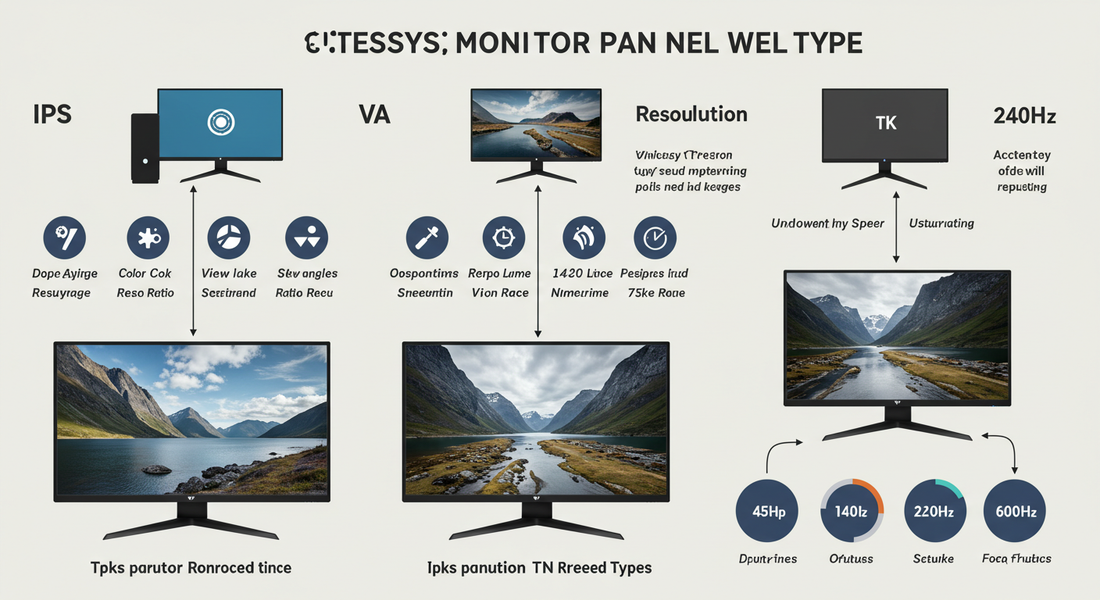
Monitor Masterclass: Understanding Resolution, Refresh Rate, and Panels
Share

Your monitor is your window to the digital world. It's the most critical piece of hardware for translating your computer's power into a visual experience. But navigating the sea of technical jargon—resolution, refresh rate, panel types—can be incredibly confusing.
How to choose a monitor that's right for you depends entirely on what you do, whether you're a competitive gamer, a creative professional, or a casual user. This masterclass will demystify the most important specs, helping you find the perfect monitor for your needs.
Resolution: Is 4K Always Better than 1440p for Gaming?
Resolution refers to the number of pixels on your screen, which determines the sharpness and clarity of the image.
-
1080p (1920 x 1080): The long-standing baseline for PC gaming. It's the easiest resolution to run, allowing for high frame rates even on budget hardware.
-
1440p / QHD (2560 x 1440): This is the current "sweet spot" for many gamers. It offers a significant jump in sharpness and detail over 1080p without being as graphically demanding as 4K.
-
4K / UHD (3840 x 2160): This offers the absolute sharpest, most detailed image possible. It's stunning for cinematic single-player games and creative work.
The 1440p vs 4K debate for gaming comes down to performance. To run modern games smoothly at 4K, you need a very powerful (and expensive) graphics card. For most gamers, especially those who play competitive titles, the high frame rates achievable at 1440p are a much better trade-off than the extra pixels of 4K.
Refresh Rate (Hz): The Key to Buttery Smooth Gameplay
Refresh rate, measured in Hertz (Hz), is the number of times your monitor updates the image on the screen every second. A higher refresh rate results in a smoother, more responsive-feeling image.
-
60Hz: The standard for basic monitors. It's fine for everyday work and slower-paced games.
-
144Hz: This is the new standard for serious gaming. The jump from 60Hz to 144Hz is a massive, immediately noticeable improvement in smoothness.
-
240Hz and higher: This is the territory of competitive esports athletes. The 144hz vs 240hz difference is less dramatic than the 60-to-144 jump, but for hyper-competitive players, that fractional advantage in smoothness and reaction time can make a difference.
Panel Types Explained: IPS, VA, or TN
The technology inside your monitor, its "panel," determines its visual characteristics. The IPS vs VA vs TN debate is about choosing between color accuracy, contrast, and speed.
-
IPS (In-Plane Switching):
-
Pro: The king of color accuracy and viewing angles. Images look vibrant and consistent, even when viewed from the side.
-
Con: Can have slightly slower response times than TN panels and generally has weaker contrast (blacks can look grayish).
-
-
VA (Vertical Alignment):
-
Pro: The master of contrast. VA panels produce deep, inky blacks, making them great for watching movies or playing dark, atmospheric games.
-
Con: Can have slower response times, sometimes resulting in "ghosting" or motion blur in fast-paced scenes.
-
-
TN (Twisted Nematic):
-
Pro: The undisputed champion of speed. TN panels have the fastest response times and can achieve the highest refresh rates, making them a long-time favorite of competitive gamers.
-
Con: They have the weakest color reproduction and the worst viewing angles.
-
Putting It All Together: Finding Your Perfect Monitor
-
For the Competitive Gamer: Your priority is speed. Look for a 1080p or 1440p TN or fast IPS panel with a 240Hz refresh rate.
-
For the All-Around Gamer/User: You want a balance of everything. The sweet spot is a 1440p IPS panel with a 144Hz-165Hz refresh rate. This gives you great colors, a sharp image, and buttery smooth gameplay.
-
For the Creative Professional/Cinematic Gamer: Your priority is visual fidelity. Look for a 4K IPS panel for the best color accuracy and sharpness. A 60Hz refresh rate is perfectly fine for this use case.
Conclusion: The Sweet Spot
Choosing a monitor is a game of trade-offs. There's no single "best" monitor, only the best monitor for you. For the vast majority of users who want a fantastic experience in gaming, creativity, and everyday use, the current sweet spot is a 27-inch, 1440p, 144Hz IPS monitor. It delivers a stunning combination of sharpness, smoothness, and vibrant color that represents the best all-around value in today's market.
